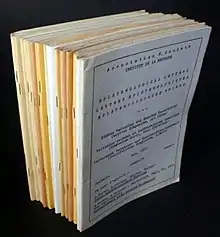Epistemological Letters
Epistemological Letters (French: Lettres Épistémologiques) was a hand-typed, mimeographed "underground" newsletter about quantum physics that was distributed to a private mailing list, described by the physicist John Clauser as a "quantum subculture", between 1973 and 1984.[2][3]
 | |
| Discipline | Quantum physics |
|---|---|
| Language | English |
| Edited by | Abner Shimony and others |
| Publication details | |
| History | 1973–1984 |
| Publisher | L'Institut de la Méthode of the Association Ferdinand Gonseth[1] (Switzerland) |
| Frequency | Irregular |
| Standard abbreviations | |
| ISO 4 | Epistemol. Lett. |
| Indexing | |
| OCLC no. | 52305299 |
Distributed by a Swiss foundation, the newsletter was created because mainstream academic journals were reluctant to publish articles about the philosophy of quantum mechanics, especially anything that implied support for ideas such as action at a distance.[4] Thirty-six or thirty-seven issues of Epistemological Letters appeared, each between four and eighty-nine pages long.[5] Several well-known scientists published their work there, including the physicist John Bell, the originator of Bell's theorem.[4] According to Clauser, much of the early work on Bell's theorem was published only in Epistemological Letters.[2]
Interpretations of quantum physics
According to the Irish physicist Andrew Whitaker, a powerful group of physicists centred on Niels Bohr, Wolfgang Pauli and Werner Heisenberg made clear that "there was no place in physics – no jobs in physics! – for anybody who dared to question the Copenhagen interpretation" (Bohr's interpretation) of quantum theory.[6] John Clauser writes that any inquiry into the "wonders and peculiarities" of quantum mechanics and quantum entanglement that went outside the "party line" was prohibited, in what he argues amounted to an "evangelical crusade".[2] Samuel Goudsmit, editor of the prestigious Physical Review and Physical Review Letters until he retired in 1974,[7] imposed a formal ban on the philosophical debate, issuing instructions to referees that they should feel free to reject material that even hinted at it.[4]
Alternative publications
Articles questioning the mainstream position were therefore distributed in alternative publications, and Epistemological Letters became one of the main conduits. The newsletter was sent out by the L'Institut de la Méthode of the Association Ferdinand Gonseth,[1] which had been established in honour of the philosopher Ferdinand Gonseth.[4] It described itself as "an open and informal journal allowing confrontation and ripening of ideas before publishing in some adequate journal."[1] According to Clauser, it announced that the usual stigma against discussing certain ideas, such as hidden-variable theories, was to be absent.[2] The newsletter's editors included Abner Shimony.[1]
Several eminent physicists published their material in Epistemological Letters, including John Bell, the originator of Bell's theorem.[4] Clauser writes that much of the early work on Bell's theorem was published only in Epistemological Letters.[2] Bell's paper, "The Theory of Local Beables" (beable, as opposed to observable, referring to something that exists independently of any observer), appeared there in March 1976.[8] Abner Shimony, John Clauser and Michael Horne published responses to it, also in the Letters.[9] Henry Stapp was another prominent physicist who wrote for the Letters.[10] H. Dieter Zeh published a paper in the Letters on the many-minds interpretation of quantum mechanics in 1981.[11]
Digitization of the Epistemological Letters
Don Howard, Professor of Philosophy at the University of Notre Dame was a Ph.D. student of Abner Shimony, one of the editors of the newsletter; as such, he had an almost complete set. In collaboration with his Notre Dame History and Philosophy of Science graduate student Sebastian Murgueitio Ramirez, the set was completed and digitized in 2018-2019, in order to make this very rare document available to the community of historians and philosophers of physics.[12] The entire set is available to the public at the Epistemological Letters digital archive, and the original newsletter is in Special Collections at the University Library.
References
- Whitaker, Andrew (2012). The New Quantum Age: From Bell's Theorem to Quantum Computation and Teleportation. Oxford: Oxford University Press. p. 145.
- Clauser, John F. (2002). "Early History of Bell's Theorem", in R. A. Bertlmann and A. Zeilinger (eds.). Quantum (Un)speakables: From Bell to Quantum Information. Springer, p. 62.
- For 1973–1984, see "Epistemological letters", Abe Books (archived), and "Epistemological letters", Amazon. Andrew Whitaker gives the dates as 1974–1984; see Whitaker 2012, p. 145.
- Kaiser, David (2011). How the Hippies Saved Physics: Science, Counterculture, and the Quantum Revival. New York and London: W. W. Norton & Company, pp. 121–122; Kaiser, David (2010). "How the Hippies Saved Physics", Cambridge Science Festival, from 00:37:35.
- For 36 issues, see "Epistemological letters", Abe Books; for 37 issues and number of pages, see Whitaker 2012, p. 145.
- Whitaker 2012, pp. 1–2.
- Bederson, Benjamin (30 June 2008). "Essay: Samuel Abraham Goudsmit (1902–1978)". Physical Review Letters. 101 (1): 010002. Bibcode:2008PhRvL.101a0002B. doi:10.1103/PhysRevLett.101.010002. PMID 18764090.
- Whitaker 2012, pp. 181–182; Bell, J. S. (1975). "The Theory of Local Beables", "6th Gift Seminar on Theoretical Physics: Quantum Field Theory", Jaca, Spain, 2–7 June 1975, reproduced in Epistemological Letters, March 1976.
- Whitaker 2012, p. 181; Shimony, A; Horne, M. A.; and Clauser, J. F. (1976). "Comment on 'The Theory of Local Beable'", Epistemological Letters, 13, pp. 1–8.
- Stapp, Henry (June 1979). "Colloquium on Bell's Theorem", Epistemological Letters, 1081.
- Zeh, H. Dieter (1981). "The Problem of Conscious Observation in Quantum Mechanical Description". Epistemological Letters, 63, courtesy of CERN (with an addendum).
- Howard, Don; Ramirez, Sebastian. "Epistemological Letters Introduction". Retrieved 27 September 2019.
Further reading
- Friere, Olival (2003). "A Story Without an Ending: The Quantum Physics Controversy 1950–1970", Science & Education, 12, pp. 573–586.
- Gusterson, Hugh (18 August 2011). "Physics: Quantum outsiders", Nature, 476, pp. 278–279.
- "Epistemological Letters", digital archive at the University of Notre Dame.